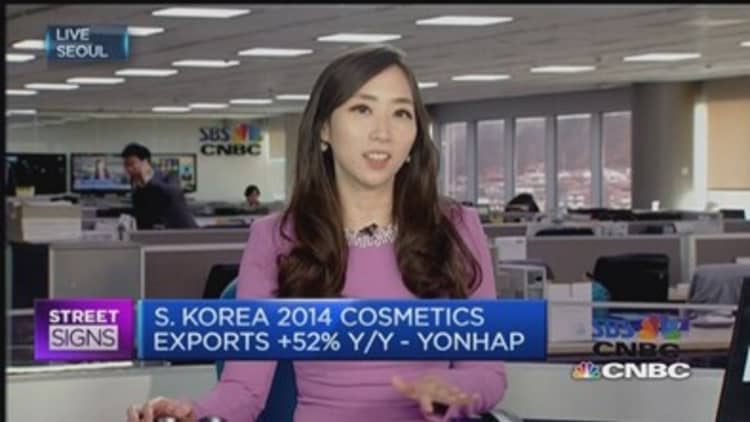South Korea's consumer stocks lost their shine during the spread of the Middle East Respiratory Syndrome (MERS) earlier this year, but as the impact of the outbreak eases, some analysts see an opportunity to pick canny bargains.
Market watchers particularly favor the country's top cosmetic makers AmorePacific Group and LG Household & Healthcare (LG H&H), which are the favorites of big-spending Chinese tourists. Both stocks have fallen 14.3 and 6.8 percent respectively since South Korea's first MERS diagnosis on May 20.
"Concern over the recovery in Chinese inbound tourist traffic and Korean companies' local sales in China seem excessive," Nomura's Cara Song wrote in a note released on Monday.
"There has been a strong recovery in [Chinese tourist] traffic after the outbreak and weakness [in the shares] provides a good opportunity for investors," Song said.
Read MoreRiding the K-wave, these Korean stocks are set to soar
Spending by mainland holidaymakers has been a key driver of South Korea's domestic consumption in recent years, with visitor arrivals from China hitting a record high of 6 million last year. However, the outbreak of MERS which claimed the lives of 36 people and infected more than 186 in South Korea earlier this year, triggered widespread panic at home and mass tour cancellations abroad.
Last month, visitor numbers fell for the third straight month to 1,069,314, down 26.5 percent from the same period in 2014, figures from the Korea Tourism Organization (KTO) showed. The number of Chinese travelers – South Korea's biggest spending visitors – plunged 32 percent on-year.
Fortunately for South Korea, the situation looks like it's on the mend. More than 300,000 Chinese holidaymakers visited South Korea in the first two weeks of September, up 4.8 percent on-year, according to a report by local media The Korea Economic Daily on Monday.
Apart from the tourism industry's faster-than-expected recovery, South Korea's beauty products are also seeing booming demand in the mainland via e-retailers or offline channels such as brand stores.
According to figures by the Korea International Trade Association, China imported $378.3 million worth of Korean-made cosmetics in the first seven months of 2015, up a whopping 250.6 percent from a year earlier, making South Korea the second-biggest cosmetic exporter to China behind France.

Market watchers feel that AmorePacific and LG H&H are better poised than other domestic cosmetic makers to capture a bigger slice of overseas sales amid growing competition from Chinese and Japanese brands.
"Local Chinese brands are growing very quickly in lower-tier cities and [posing intense] competition in higher-tier cities. Furthermore, Chinese consumers are becoming increasingly attracted to Japanese products [because] product quality is high and prices have become more affordable. Only AmorePacific's 'Sulwhasoo' and LG H&H's 'WHOO' are well positioned to survive," the note cited online retailer VIP Shop Korea's CEO Mr. Shin as saying.
These factors bode well for the stocks of cosmetic makers, said Nomura's Song, who has a target price of 550,000 won and 1,083,600 won for AmorePacific and LG H&H, representing more than 47 and 29 percent upside from current trading levels, respectively.
Daewoo Securities' analyst Regina Hahm is also overweight South Korean cosmetic makers.
"I'm bullish on the cosmetic sector as a whole. [The selloff] wasn't about fundamentals; it was purely [driven by] external factors that are unexpected. It hasn't changed the core competitiveness that South Korean players have over global cosmetic brands," Seoul-based Hahm told CNBC by phone.
Read MoreFood and fashion: How K-drama is influencing Asia
Apart from the popularity of South Korean pop-culture abroad, higher product quality and reasonable price points compared to foreign rivals underpin the burgeoning appetite for Korean-made cosmetics in overseas markets, she said.
"[Even with a weaker yen] the price difference in Japanese brands is marginal," said Hahm who recommends buying LG H&H and AmorePacific as long-term investments.
Apart from cosmetic makers, Daewoo Securities' Hahm also names Hotel Shilla – part of the Samsung Group and the world's No.6 duty free operator – as one of her top picks in the consumer space.
"The impact from MERS will likely be short term and the company will recover in the third quarter. Hotel Shilla will also be opening a new duty free shop with Hyundai Development [and] that would give them better bargaining power ahead," she told CNBC.
Hotel Shilla, in a joint bid with Hyundai Development, was awarded a license in July to operate duty free stores in downtown Seoul. Both companies plan to build a 27,400-square meter store that would be the world's biggest downtown duty free outlet, with parking for 400 tour buses.
Correction: An earlier version misspelled Sulwhasoo.

